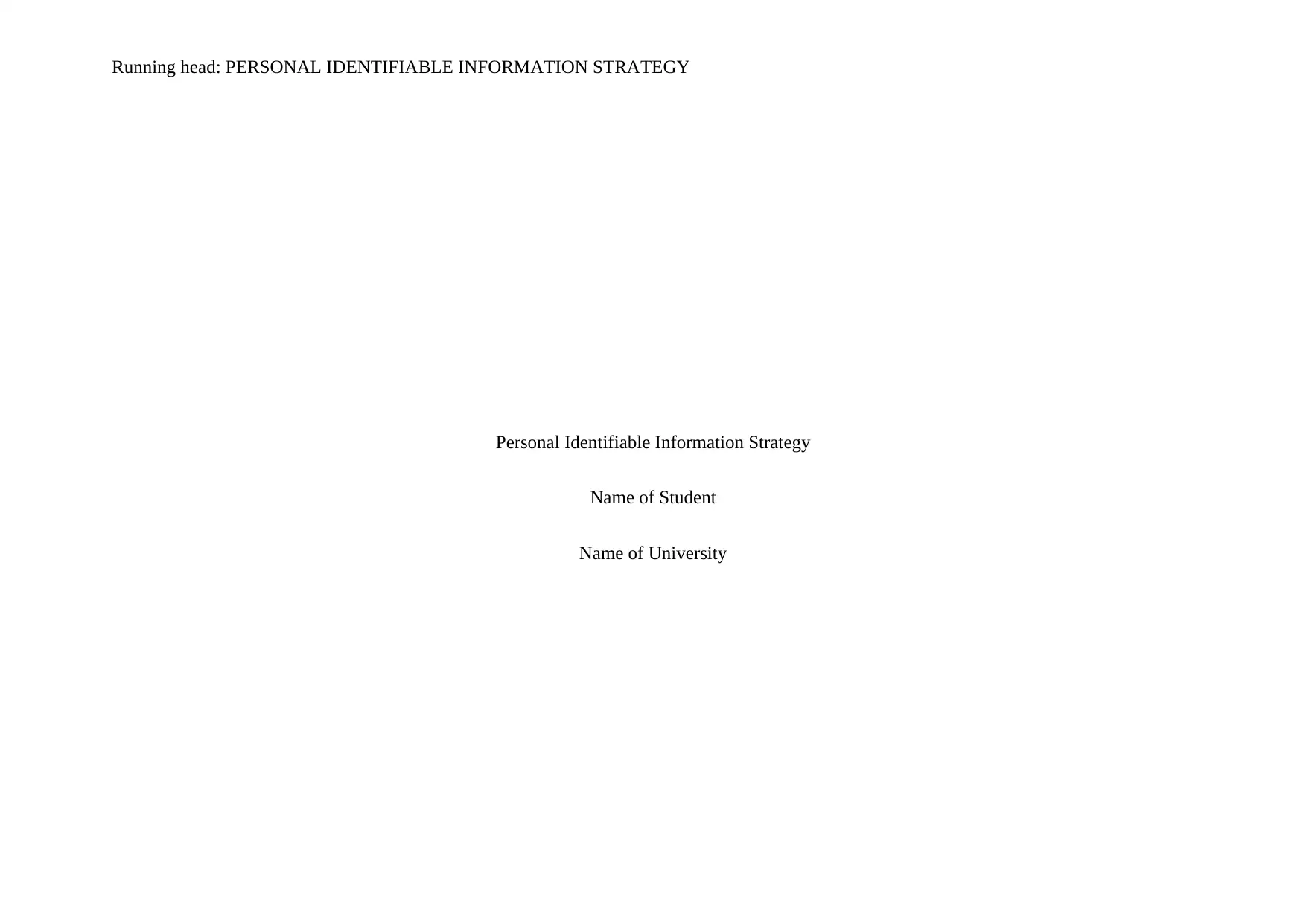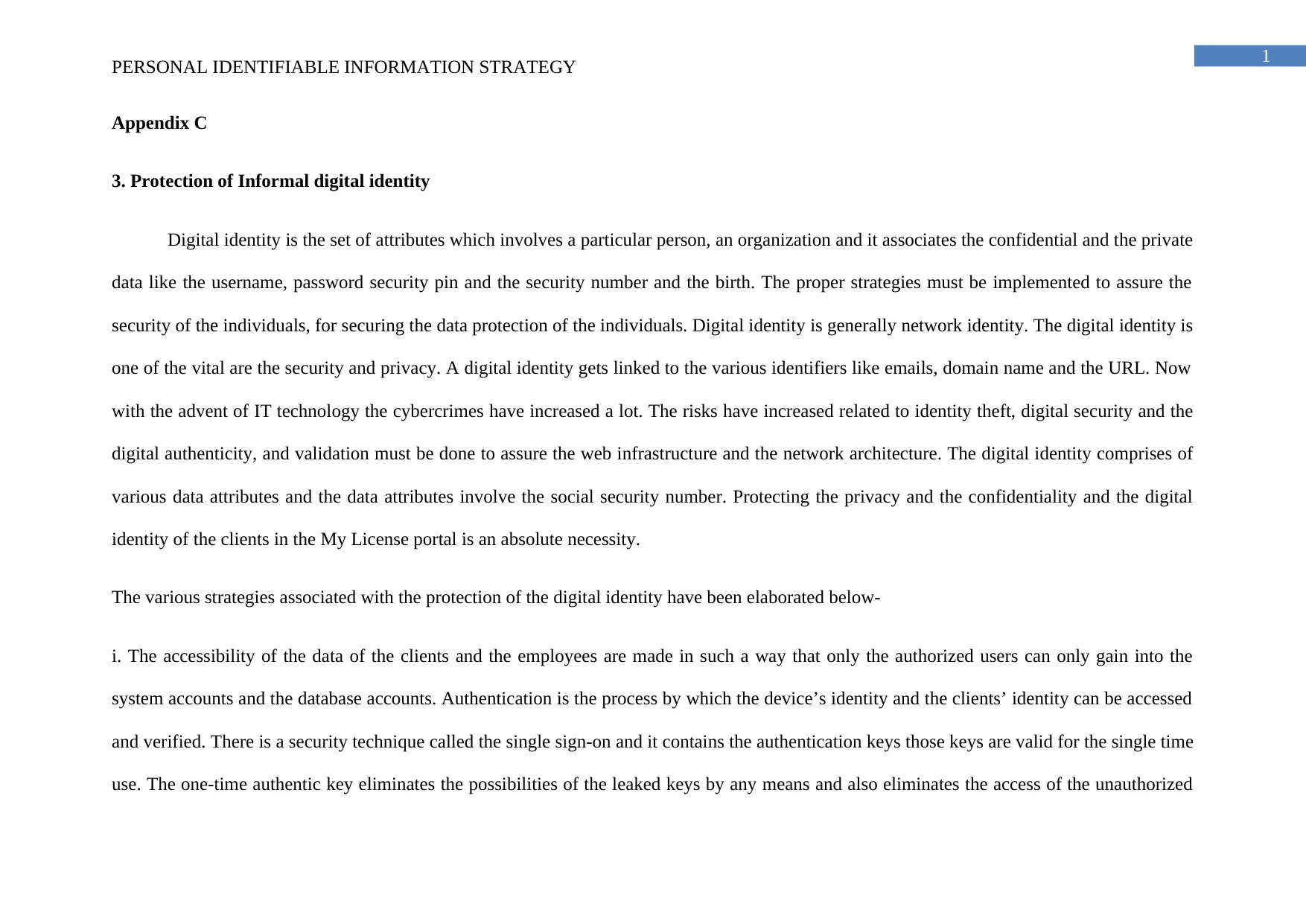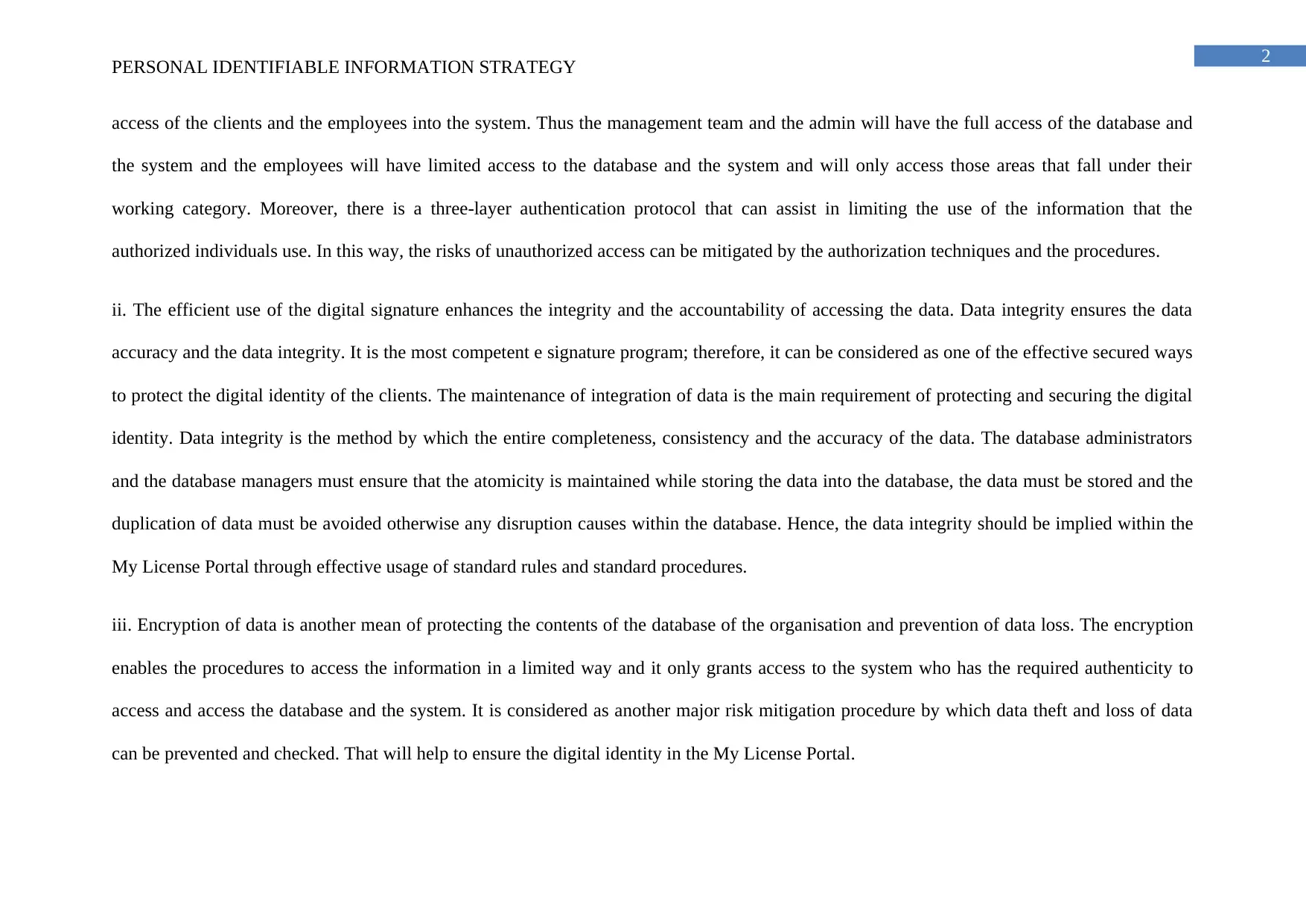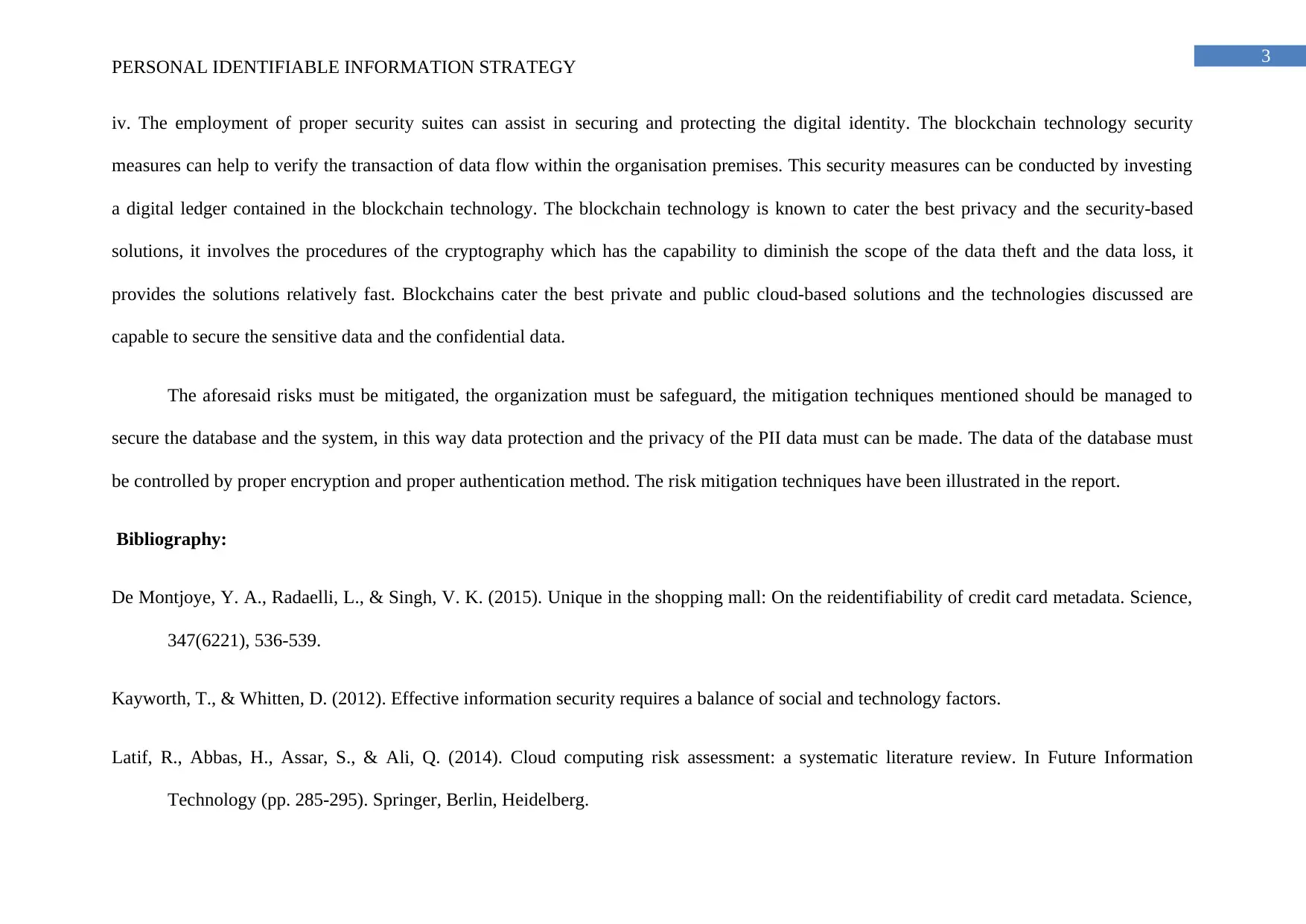University PII Strategy: Protecting Digital Identity and Data
VerifiedAdded on 2020/05/11
|4
|1013
|209
Report
AI Summary
This report focuses on a Personal Identifiable Information (PII) strategy designed to protect digital identity. It emphasizes the importance of securing confidential and private data, especially in the context of increasing cybercrimes. The report details various strategies, including limiting data access through authentication protocols like single sign-on and three-layer authentication, ensuring data integrity via digital signatures, encrypting data to restrict access, and employing security suites like blockchain technology. These measures aim to mitigate risks such as identity theft and data loss, ensuring the privacy and confidentiality of client data within the My License portal. The report highlights the significance of data integrity, atomicity, and the use of encryption to safeguard sensitive information. It concludes by stressing the necessity of implementing these risk mitigation techniques to secure databases and systems, ultimately protecting PII and digital identities.

Running head: PERSONAL IDENTIFIABLE INFORMATION STRATEGY
Personal Identifiable Information Strategy
Name of Student
Name of University
Personal Identifiable Information Strategy
Name of Student
Name of University
Paraphrase This Document
Need a fresh take? Get an instant paraphrase of this document with our AI Paraphraser

1
PERSONAL IDENTIFIABLE INFORMATION STRATEGY
Appendix C
3. Protection of Informal digital identity
Digital identity is the set of attributes which involves a particular person, an organization and it associates the confidential and the private
data like the username, password security pin and the security number and the birth. The proper strategies must be implemented to assure the
security of the individuals, for securing the data protection of the individuals. Digital identity is generally network identity. The digital identity is
one of the vital are the security and privacy. A digital identity gets linked to the various identifiers like emails, domain name and the URL. Now
with the advent of IT technology the cybercrimes have increased a lot. The risks have increased related to identity theft, digital security and the
digital authenticity, and validation must be done to assure the web infrastructure and the network architecture. The digital identity comprises of
various data attributes and the data attributes involve the social security number. Protecting the privacy and the confidentiality and the digital
identity of the clients in the My License portal is an absolute necessity.
The various strategies associated with the protection of the digital identity have been elaborated below-
i. The accessibility of the data of the clients and the employees are made in such a way that only the authorized users can only gain into the
system accounts and the database accounts. Authentication is the process by which the device’s identity and the clients’ identity can be accessed
and verified. There is a security technique called the single sign-on and it contains the authentication keys those keys are valid for the single time
use. The one-time authentic key eliminates the possibilities of the leaked keys by any means and also eliminates the access of the unauthorized
PERSONAL IDENTIFIABLE INFORMATION STRATEGY
Appendix C
3. Protection of Informal digital identity
Digital identity is the set of attributes which involves a particular person, an organization and it associates the confidential and the private
data like the username, password security pin and the security number and the birth. The proper strategies must be implemented to assure the
security of the individuals, for securing the data protection of the individuals. Digital identity is generally network identity. The digital identity is
one of the vital are the security and privacy. A digital identity gets linked to the various identifiers like emails, domain name and the URL. Now
with the advent of IT technology the cybercrimes have increased a lot. The risks have increased related to identity theft, digital security and the
digital authenticity, and validation must be done to assure the web infrastructure and the network architecture. The digital identity comprises of
various data attributes and the data attributes involve the social security number. Protecting the privacy and the confidentiality and the digital
identity of the clients in the My License portal is an absolute necessity.
The various strategies associated with the protection of the digital identity have been elaborated below-
i. The accessibility of the data of the clients and the employees are made in such a way that only the authorized users can only gain into the
system accounts and the database accounts. Authentication is the process by which the device’s identity and the clients’ identity can be accessed
and verified. There is a security technique called the single sign-on and it contains the authentication keys those keys are valid for the single time
use. The one-time authentic key eliminates the possibilities of the leaked keys by any means and also eliminates the access of the unauthorized

2
PERSONAL IDENTIFIABLE INFORMATION STRATEGY
access of the clients and the employees into the system. Thus the management team and the admin will have the full access of the database and
the system and the employees will have limited access to the database and the system and will only access those areas that fall under their
working category. Moreover, there is a three-layer authentication protocol that can assist in limiting the use of the information that the
authorized individuals use. In this way, the risks of unauthorized access can be mitigated by the authorization techniques and the procedures.
ii. The efficient use of the digital signature enhances the integrity and the accountability of accessing the data. Data integrity ensures the data
accuracy and the data integrity. It is the most competent e signature program; therefore, it can be considered as one of the effective secured ways
to protect the digital identity of the clients. The maintenance of integration of data is the main requirement of protecting and securing the digital
identity. Data integrity is the method by which the entire completeness, consistency and the accuracy of the data. The database administrators
and the database managers must ensure that the atomicity is maintained while storing the data into the database, the data must be stored and the
duplication of data must be avoided otherwise any disruption causes within the database. Hence, the data integrity should be implied within the
My License Portal through effective usage of standard rules and standard procedures.
iii. Encryption of data is another mean of protecting the contents of the database of the organisation and prevention of data loss. The encryption
enables the procedures to access the information in a limited way and it only grants access to the system who has the required authenticity to
access and access the database and the system. It is considered as another major risk mitigation procedure by which data theft and loss of data
can be prevented and checked. That will help to ensure the digital identity in the My License Portal.
PERSONAL IDENTIFIABLE INFORMATION STRATEGY
access of the clients and the employees into the system. Thus the management team and the admin will have the full access of the database and
the system and the employees will have limited access to the database and the system and will only access those areas that fall under their
working category. Moreover, there is a three-layer authentication protocol that can assist in limiting the use of the information that the
authorized individuals use. In this way, the risks of unauthorized access can be mitigated by the authorization techniques and the procedures.
ii. The efficient use of the digital signature enhances the integrity and the accountability of accessing the data. Data integrity ensures the data
accuracy and the data integrity. It is the most competent e signature program; therefore, it can be considered as one of the effective secured ways
to protect the digital identity of the clients. The maintenance of integration of data is the main requirement of protecting and securing the digital
identity. Data integrity is the method by which the entire completeness, consistency and the accuracy of the data. The database administrators
and the database managers must ensure that the atomicity is maintained while storing the data into the database, the data must be stored and the
duplication of data must be avoided otherwise any disruption causes within the database. Hence, the data integrity should be implied within the
My License Portal through effective usage of standard rules and standard procedures.
iii. Encryption of data is another mean of protecting the contents of the database of the organisation and prevention of data loss. The encryption
enables the procedures to access the information in a limited way and it only grants access to the system who has the required authenticity to
access and access the database and the system. It is considered as another major risk mitigation procedure by which data theft and loss of data
can be prevented and checked. That will help to ensure the digital identity in the My License Portal.
⊘ This is a preview!⊘
Do you want full access?
Subscribe today to unlock all pages.

Trusted by 1+ million students worldwide

3
PERSONAL IDENTIFIABLE INFORMATION STRATEGY
iv. The employment of proper security suites can assist in securing and protecting the digital identity. The blockchain technology security
measures can help to verify the transaction of data flow within the organisation premises. This security measures can be conducted by investing
a digital ledger contained in the blockchain technology. The blockchain technology is known to cater the best privacy and the security-based
solutions, it involves the procedures of the cryptography which has the capability to diminish the scope of the data theft and the data loss, it
provides the solutions relatively fast. Blockchains cater the best private and public cloud-based solutions and the technologies discussed are
capable to secure the sensitive data and the confidential data.
The aforesaid risks must be mitigated, the organization must be safeguard, the mitigation techniques mentioned should be managed to
secure the database and the system, in this way data protection and the privacy of the PII data must can be made. The data of the database must
be controlled by proper encryption and proper authentication method. The risk mitigation techniques have been illustrated in the report.
Bibliography:
De Montjoye, Y. A., Radaelli, L., & Singh, V. K. (2015). Unique in the shopping mall: On the reidentifiability of credit card metadata. Science,
347(6221), 536-539.
Kayworth, T., & Whitten, D. (2012). Effective information security requires a balance of social and technology factors.
Latif, R., Abbas, H., Assar, S., & Ali, Q. (2014). Cloud computing risk assessment: a systematic literature review. In Future Information
Technology (pp. 285-295). Springer, Berlin, Heidelberg.
PERSONAL IDENTIFIABLE INFORMATION STRATEGY
iv. The employment of proper security suites can assist in securing and protecting the digital identity. The blockchain technology security
measures can help to verify the transaction of data flow within the organisation premises. This security measures can be conducted by investing
a digital ledger contained in the blockchain technology. The blockchain technology is known to cater the best privacy and the security-based
solutions, it involves the procedures of the cryptography which has the capability to diminish the scope of the data theft and the data loss, it
provides the solutions relatively fast. Blockchains cater the best private and public cloud-based solutions and the technologies discussed are
capable to secure the sensitive data and the confidential data.
The aforesaid risks must be mitigated, the organization must be safeguard, the mitigation techniques mentioned should be managed to
secure the database and the system, in this way data protection and the privacy of the PII data must can be made. The data of the database must
be controlled by proper encryption and proper authentication method. The risk mitigation techniques have been illustrated in the report.
Bibliography:
De Montjoye, Y. A., Radaelli, L., & Singh, V. K. (2015). Unique in the shopping mall: On the reidentifiability of credit card metadata. Science,
347(6221), 536-539.
Kayworth, T., & Whitten, D. (2012). Effective information security requires a balance of social and technology factors.
Latif, R., Abbas, H., Assar, S., & Ali, Q. (2014). Cloud computing risk assessment: a systematic literature review. In Future Information
Technology (pp. 285-295). Springer, Berlin, Heidelberg.
1 out of 4
Related Documents
Your All-in-One AI-Powered Toolkit for Academic Success.
+13062052269
info@desklib.com
Available 24*7 on WhatsApp / Email
![[object Object]](/_next/static/media/star-bottom.7253800d.svg)
Unlock your academic potential
Copyright © 2020–2025 A2Z Services. All Rights Reserved. Developed and managed by ZUCOL.



